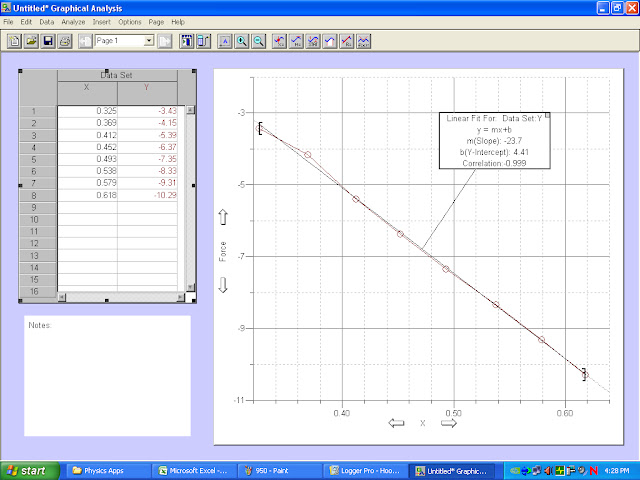Introduction
To determine the force constant of a spring and to study the motion of a spring and mass
when vibrating under influence of gravity. When a spring is stretched a distance x from its equilibrium position, it will exert a restoring force directly proportional to this distance. We write this restoring force, F, as: F = -kx. where k is the spring constant and depends on the stiffness of the spring. The minus
sign remind us that the direction of the force is opposite to the displacement. Equation 1 is valid for most springs and is called Hooke’s Law. If a mass is attached to a spring that is hung vertically, and the mass is pulled down and released, the spring and the mass will oscillate about the original point of equilibrium. Using Newton’s second law and some calculus we can show that the motion is periodic (repeats itself over and over) and has period, T (in sec), given by T =[(4pi^2)/k)m]^(1/2)
Calculations
F = -kx
T =[(4pi^2)/k)m]^(1/2)
Data
| Mass (kg) | Force (N) | Initial (m) | Final (m) | Period (s) | Amplitude (m) | Frequency (Hz) | Period^2 (s) |
| 0 | 0.177 | 0.277 | |||||
| 0.35 | -3.43 | 0.325 | 0.425 | 0.784 | 0.0895 | 1.276 | 0.5824 |
| 0.45 | -4.41 | 0.369 | 0.469 | 0.884 | 0.0892 | 1.131 | 0.7488 |
| 0.55 | -5.39 | 0.412 | 0.512 | 0.972 | 0.0857 | 1.029 | 0.9152 |
| 0.65 | -6.37 | 0.452 | 0.552 | 1.056 | 0.1025 | 0.947 | 1.0816 |
| 0.75 | -7.35 | 0.493 | 0.593 | 1.134 | 0.0891 | 0.882 | 1.2481 |
| 0.85 | -8.33 | 0.538 | 0.638 | 1.21 | 0.0676 | 0.826 | 1.4145 |
| 0.95 | -9.31 | 0.579 | 0.679 | 1.268 | 0.0887 | 0.789 | 1.5809 |
| 1.05 | -10.29 | 0.618 | 0.718 | 1.346 | 0.0784 | 0.743 | 1.7473 |
1050g Positon vs Time
 |
| Here is the postion vs time graph for the spring loaded with a mass of 1050g with a sinusoidal fit |
350g Position vs Time
Here is the postion vs time graph for the spring loaded with a mass of 1050g
Force vs Displacement of all Runs
 |
| This the Force vs Displacement graph for all of the runs 350g through 1050g |
In this lab we went over Hooks law of springs. We learned how to find a spring constant (k) by having a known mass, a length of displacement of the spring. The spring is stretched and the mass is attached and let go for 10 seconds. The spring oscillates and the position vs time is recorded. the spring constant can be calculated using F=-kx


No comments:
Post a Comment